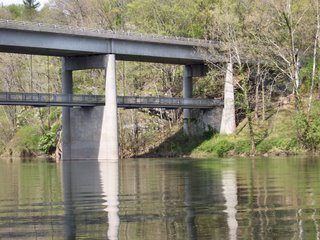The Importance of Bridges to Wildlife

Image: by D L Ennis, bridge on the Blue Ridge Parkway crossing the James River
Bridges obviously serve a very important role in our ability to traverse over lakes, streams, rivers, roads, railroads, and a multitude of other obstacles. In our travels we typically drive across bridges and give little thought to what might be residing beneath them. But did you know that bridges are important for wildlife too? Some of you may be familiar with the highly publicized Congress Avenue Bridge in Austin, Texas where 1.5 million Mexican free-tailed bats and their young roost. Or perhaps you have seen osprey or gulls nesting on bridges along the coast. But you may be surprised to know that there are a number of different species that have adopted bridges as a place to rest, feed, or raise their young.
Because bridges have become an important habitat structure used by wildlife, the Virginia Department of Game and Inland Fisheries have begun documenting where and how wildlife is using bridges in Virginia. What started out as "opportunistic sightings" has turned into a full-scale "Wildlife and Bridges" project. VDGIF is working with Dr. Bill McShea of the Wildlife Conservation Society and the Virginia Department of Transportation to better understand the types of bridges and associated habitats that draw wildlife to them.
Research done by members of the "Wildlife and Bridges" project has revealed, thus far, that seven species of birds, eight species of mammals, and one reptile use bridges. The birds include barn swallow (Hirundo rustica), northern rough-winged swallow (Stelgidopteryx serripennis), and cliff swallows (Petrochelidon pyrrhonota); rock dove or domestic pigeon (Columba livia); eastern phoebe (Sayornis phoebe); osprey (Pandion haliaetus); and peregrine falcon (Falco peregrinus). The mammals include rafinesque's big-eared bat (Plecotus rafinesquii), little brown bat (Myotis lucifugus), big brown bat (Eptesicus fuscus), eastern pipistrelle bat (Pipistrellus subflavus), gray bat (Myotis grisescens), and northern long-eared bat (Myotis septentrionalis); woodrats (Neotoma floridana); and gray fox (Urocyon cinereoargenteus). The only reptile that has been found so far was a black rat snake (Elaphe obsoleta obsolete) that was feeding on a bat. That is a total of 16 different species of wildlife that have been found utilizing bridges so far. It is expected that as the project progresses it will be found that more species use bridges.

Image: by D L Ennis, cliff swallows nests under the bridge in the above image
While Virginia doesn't have a situation like that at the Congress Avenue Bridge in Austin, we do have bridges that contain sizable wildlife populations. The actual number of individuals varies depending on the species. Peregrine falcons, for example, are highly territorial and will not tolerate another pair in their vicinity. Therefore, you could only expect one pair of peregrines at a bridge. However, bats and swallows are communal breeders; finding 20 to 50 cliff swallow nests or 100's or even 1,000's of breeding bats would not be unusual. With viewable wildlife becoming a popular pastime, through this project, it is hoped to be able to identify bridges that would be of interest to the naturalist.
The study has looked at bridges throughout the state and found that wildlife uses bridges across all of Virginia. However, when they looked at bridge use in the three major physiographic regions (coastal plain, piedmont, and mountains); some differences in bridge use were found among these regions. The coastal plain has shown the least amount of use so far with only 18.4% of the bridges being occupied by four species of birds and one species of mammal. The mountain region follows with 34.8% of the bridges being occupied by five species of birds and seven species of mammals. In the Piedmont Region of the state 50% of the bridges are being occupied by five species of birds, three species of mammals, and one reptile. These are preliminary data and as additional bridges in each of the physiographic regions are examined these numbers will likely change.
An understanding of the types of bridges and surrounding habitats being used by wildlife will help the state to better manage the wildlife of Virginia. There may be situations where it would be beneficial to either enhance or discourage bridge use by wildlife. By understanding the structural components of the bridge or surrounding habitat that attract or discourage wildlife management strategies can be developed for individual bridges or groups of bridges over larger areas. In a few cases the study has found rare or endangered or threatened wildlife using bridges. The use of this artificial habitat may be a key component in helping to promote some rare species and add to their recovery. As the human population grows our need to understand human-wildlife interactions becomes more important in the use of our natural resources. This project is focused on adding to our knowledge and understanding of Virginia's wildlife and how we can coexist.












1 Comments:
At Tuesday, 13 June, 2006, John B. said…
John B. said…
If you cross the Bay Bridge from Annapolis to the Eastern Shore at certain times of year, you can see hundreds of cormorants roosting along the understructure of the bridges.
One aspect of bridge use that may or may not be covered in the study is the use of bridges for transit - either during migration or to travel from one part of a territory to another. Of course, this would mainly apply to mammals and other non-flying creatures.
Out west the federal government is starting a project to build bridges and tunnels for wildlife to cross major highways as they travel through their ranges.
Post a Comment
<< Home